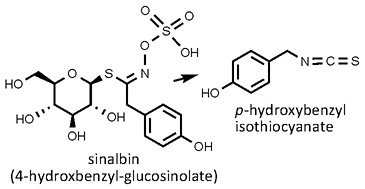 Sinapis alba
Sinapis alba
white mustard
Back to “Spices: white mustard (Sinapis alba)s”
Sinapis alba L. (Brassicaceae); wit mosterd (Afrikaans); bai jie (Chinese); gele mosterd (Dutch); moutarde blanche (French); Weißer Senf (German); senape bianca (Italian); shiro garashi (Japanese); mostarda branca (Portuguese); mostaza blanca (Spanish); senap (Swedish)
DESCRIPTION The small, spherical seeds are white or yellowish in some modern cultivars but wild forms originally had black or brown seeds so that seed colour alone is not a reliable way to identify white mustard.1 Yellow-seeded brown mustards (called “orientals”) add to the confusion. Unlike black and brown mustard, white mustard emits no odour when the seeds are crushed but the taste is more pungent and slightly bitter.1
THE PLANT A robust and leafy annual, easily identified when in fruit by the hairy capsules which have flat, wing-like tips. In black and brown mustard, the fruits are hairless and the tips are rounded and tapering.
ORIGIN White mustard spread from the eastern Mediterranean region to other parts of Europe during the Middle Ages.2 Mustard has an interesting history in the Middle East and Europe, as one of the most important condiments of the ancient world for flavouring meat and fish. This tradition has been perpetuated in France and England since the time of the Romans but the style of French and English mustards differ. French mustards are sold in the form of a paste made with verjuice (acidic juice of unripe grapes) and white wine (Dijon mustard), with wine vinegar (Orleans mustard) or with grape must (Bordeaux mustard).3 Another type is the colourful Meaux mustard, made with vinegar and crushed mustard seeds of different colours.3 English mustard is a mixture of black and white mustard, either sold as a fine powder, in which turmeric is an ingredient (the mustard is prepared in the kitchen as required), or the powder is mixed with water or vinegar and presented as a ready-to-use paste. Italian Cremona mustard is made from macerated fruits mixed with a sweet and sour mustard sauce.3
CULTIVATION White mustard is grown from seeds as an annual crop. Many different cultivars are available, including forms developed for fodder and oil production. The main producers are the United States, Canada, the United Kingdom and parts of Europe.
HARVESTING Seeds are mechanically harvested when fully ripe.
CULINARY USES Mustard is commonly used as a condiment with hot or cold meats, sausages and other charcuterie items and is often served alongside tomato sauce (ketchup) and vinegar in fast food outlets. It is used as a flavour ingredient in many dishes and numerous sauces (e.g. vinaigrette, mayonnaise, Cambridge sauce and barbeque sauce).
FLAVOUR COMPOUNDS The main mustard-oil glycoside in white mustard is not sinigrin but sinalbin (4-hydroxybenzyl-glucosinolate), which is hydrolysed by the enzyme myrosinase to produce the pungent p-hydroxybenzyl isothiocyanate.4 The addition of liquids activates the enzyme. Water and beer give a hot taste, wine gives a pungent, spicy flavour and water or vinegar gives a mild flavour (English mustard).1

NOTES Powdered mustard seeds have many uses in the food industry as a flavour enhancer, binder, emulsifier and bulking agent.1
1. Farrel, K.T. 1999. Spices, condiments and seasonings. Aspen Publishers, Gaithersburg, USA.
2. Hemingway, J.S. 1995. Mustards. In: Smartt, J., Simmonds, N.W. (Eds), Evolution of crop plants (2nd ed.), pp. 82–86. Longman, London.
3. Larousse. 1999. The concise Larousse gastronomique. Hamlyn, London.
4. Choubdar, N., Li, S., Holley, R.A. 2010. Supercritical fluid chromatography of myrosinase reaction products in ground yellow mustard seed oil. Journal of Food Science 75: 341−345.